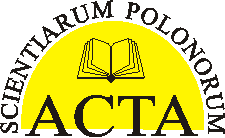Title
Effect of calcium carbonate and differentiated nitrogen fertilization upon the yield and chemical composition of spinach beet
Autor
Katarzyna Dzida, Zbigniew Jarosz
Keywords
spinach beet, localized fertilization, nitrates, chemical composition of leaves
Abstract
Fertilizing cultivable plants is an effective way of improving yield quantity and quality. The studies conducted in the years 2008–2009 were aimed at determining the relationship between the kind of nitrogen fertilizer, manner of its application, as well as the dose of calcium carbonate and the plant unit weight, as well as chemical composition of spinach beet, grown in glasshouse in the spring period. Nitrogen was applied in the form of ammonium sulphate and urea in a localized form (N-deposit) and in the form of solution. Calcium was administered in the form of calcium carbonate in the doses of 5 and 15 g · dm-3 of substratum. The length of leaves, plant unit weight and selected parameters of beet leaf utility value were assessed. The substratum was also analyzed after plant harvest. The highest unit weight of plants was obtained with the application of ammonium sulfate in the form of a solution with a lower calcium carbonate dose, compared to the remaining combinations. The examined spinach beet plants were distinguished by high contents of dry matter, protein, total nitrogen, potassium, calcium and magnesium The chemical composition of leaves was significantly differentiated, depending on the examined factors. The contents of nitrates in the leaf dry matter ranged from 0.26 to 0.45%, depending on the kind of nitrogen fertilizer and manner of its application. The applied nitrogen fertilization to a small extent influenced the concentration of nitrates in beet leaves. More nitrates were contained in plants fed by a higher dose of calcium carbonate, compared to the plants which were given a lower dose of CaCO3. The highest content of vitamin C and the lowest share of nitrates in leaf dry matter were obtained with the application of urea in the form of deposit with a lower dose of calcium carbonate.
Pages
201-210
Cite
Dzida, K., Jarosz, Z. (2010). Effect of calcium carbonate and differentiated nitrogen fertilization upon the yield and chemical composition of spinach beet. Acta Sci. Pol. Hortorum Cultus, 9(3), 201-210.
Full text


